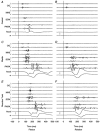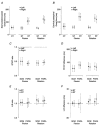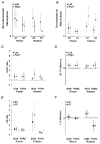Startle response of human neck muscles sculpted by readiness to perform ballistic head movements
- PMID: 11507178
- PMCID: PMC2278755
- DOI: 10.1111/j.1469-7793.2001.00289.x
Startle response of human neck muscles sculpted by readiness to perform ballistic head movements
Abstract
1. An acoustic startle stimulus delivered in place of a 'go' signal in a voluntary reaction time (RT) task has been shown previously to advance the onset latency of a prepared distal limb movement without affecting the amplitude of the muscle response or movement kinematics. The primary goal of this study was to use muscles with a larger startle response to investigate whether the startling stimulus only triggered the RT movement or whether some form of interaction occurred between a startle response and a temporally advanced RT movement. 2. Twenty healthy male or female subjects were instructed to react as quickly as possible to an acoustic 'go' stimulus by performing a ballistic head flexion or right axial rotation. The 'go' stimulus was periodically replaced by an acoustic stimulus capable of eliciting a startle reflex. Separate startle-inducing stimuli under relaxed conditions before and after the movement trials served as control trials (CT trials). Bilateral surface electromyography of the orbicularis oculi, masseter, sternocleidomastoid and cervical paraspinal muscles, and head-mounted transducers were used to measure the muscle response and movement kinematics. 3. Muscle activation times in startled movement trials (ST trials) were about half those observed in RT trials, and were not significantly different from those observed in the startle CT trials. The duration of head acceleration was longer in ST trials than in RT trials and the amplitude of both the neck muscle electromyogram (EMG) and head kinematics was larger during ST trials than during RT trials. The EMG amplitude of ST trials was biased upward rather than scaled upward compared with the EMG amplitude of RT trials. 4. Over the 14 ST trials used in this experiment, no habituation of the reflex response was observed in the muscles studied. This absence of habituation was attributed to a combination of motor readiness and sensory facilitation. 5. The results of this experiment indicated that the neck muscle response evoked by a startling acoustic stimulus in the presence of motor readiness could be described as a facilitated startle reflex superimposed on a temporally advanced, pre-programmed, voluntary RT movement. Parallel reticular pathways to the neck muscle motoneurones are proposed as a possible explanation for the apparent summation of the startle and voluntary movement responses.
Figures




References
-
- Bonato P, D'Alessio T, Knaflitz M. A statistical method for the measurement of muscle activation intervals from surface myoelectric signals during gait. IEEE Transactions on Biomedical Engineering. 1998;45:287–299. - PubMed
-
- Brown P, Rothwell J C, Thompson P D, Britton T C, Day B L, Marsden C D. New observations on the normal auditory startle reflex in man. Brain. 1991;114:1891–1902. - PubMed
-
- Brunia C H M. Waiting in readiness: gating in attention and motor preparation. Psychophysiology. 1993;30:327–339. - PubMed
-
- Chokroverty S, Walczak T, Hening W. Human startle reflex: technique and criteria for abnormal response. Electroencephalography and Clinical Neurophysiology. 1992;85:236–242. - PubMed
-
- Corcos D M, Gottlieb G L, Latash M L, Almeida G L, Agarwal G C. Electromechanical delay: an experimental artifact. Journal of Electromyography and Kinesiology. 1992;2:59–68. - PubMed
Publication types
MeSH terms
LinkOut - more resources
Full Text Sources
Other Literature Sources

